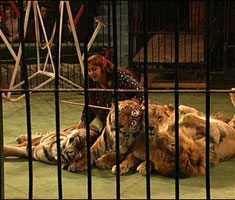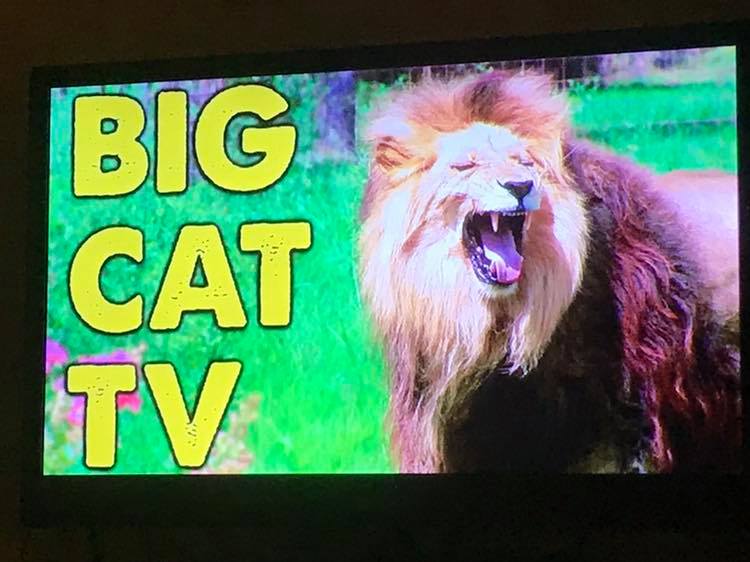Circus Jobs
Would a Big Cat Ban Result in Lost Jobs?
People who make a living pimping out cubs and forcing big cats to do un natural acts in the circus ring will tell you that a ban on big cat possession will result in a loss of jobs, but that isn’t true. Here’s why:
Big Cats in the Circus or Performing Acts
 In the case of big cats in circus acts or nightclub acts, there is typically one trainer and maybe one assistant. 2 paying jobs. According to the U.S. Department of Labor, a “good” lion tamer will earn up to $17,000 to $54,000 a year. There might be 6-12 lions or tigers in the act. Even though most acts only will have half their cats in any given show, they always have to have extra lions and tigers for the show because big cats are solitary by nature and don’t want to be that close to others of their own kind. They frequently lash out at each other and you can’t have a cat on display with gaping wounds, so those big cats are kept out of sight until they heal.
In the case of big cats in circus acts or nightclub acts, there is typically one trainer and maybe one assistant. 2 paying jobs. According to the U.S. Department of Labor, a “good” lion tamer will earn up to $17,000 to $54,000 a year. There might be 6-12 lions or tigers in the act. Even though most acts only will have half their cats in any given show, they always have to have extra lions and tigers for the show because big cats are solitary by nature and don’t want to be that close to others of their own kind. They frequently lash out at each other and you can’t have a cat on display with gaping wounds, so those big cats are kept out of sight until they heal.
Just proper food and vet care runs about $10,000 per big cat, per year. This act is costing the circus owner $120,000 a year for the lions and tigers (not even counting the expense of shipping big cats every week to a new venue) plus two big cat wranglers. A big circus can probably afford a higher end trainer at $54,000 plus the assistant, at the lower end of the pay grade at $17,000. So the total is conservatively $191,000.00 annually.
 Cirque du Soleil is said to start their acrobats at $30,000 a year, so this same circus could employ 6 humans for what it is paying for 2 humans and a train load of dangerous captive carnivores.
Cirque du Soleil is said to start their acrobats at $30,000 a year, so this same circus could employ 6 humans for what it is paying for 2 humans and a train load of dangerous captive carnivores.
What about those big cat handlers? What kind of jobs can they get if they can’t get paid to whip and shock lions and tigers into compliance?
Prison guard or bar bouncer are the first jobs that come to mind. If they can deal with angry cats that are three times their size, they can surely manage to find some sort of employment that doesn’t involve beating up animals.
In its current form the Big Cat Public Safety Act would allow the large circuses who have trapeze acts and acrobats to continue breeding and using big cats. During the era of Gunther Gebel-Williams (1968-1990) the circus bred and used their own tigers. Under the new law they would be allowed to continue doing that.
We don’t believe that big cats should be used in circus acts, but the circus has a very powerful lobby in Washington, thanks to large donations from Kenneth Feld of Ringling Brothers Circus. Ringling doesn’t own any tigers, but hires outside acts. From USDA census reports in 2014 there were only 68 tigers in U.S. circus acts. There are around 200 tigers in legitimate, AZA accredited zoos. Together those tigers account for only 5% of the tigers languishing in cages. Scroll to the bottom of the page for a list of circuses and their 2014 reported numbers of tigers.
So why is the circus fighting the Big Cat Public Safety Act? Keeping big cats is hard work, so it is easier to hire outside acts. When they are repeatedly cited for animal neglect and abuse, it doesn’t reflect on the circus, but rather on the individual who owns the cats and they are expendable. (Notice that you can’t name a tiger tamer after Gunther Gebel-Williams.)
Another reason is because the cats you see in circus and performing acts are usually under the age of 5, which is when they are fully matured and won’t put up with being kicked around any more. There is no legitimate use for these cats, as they are not purebred and thus serve no conservation breeding program in legitimate AZA accredited zoos. They have to be disposed of, and it became illegal to dump them into the pet trade in 2003, so the circuses don’t want to provide cradle to grave support for lions and tigers who can live into their twenties. The more money the circus has to spend on animals, who no longer earn their keep, the less they can afford to offer paying jobs to human performers.
Banning the use of wild animals in performing acts results in more jobs for people, not fewer!
1. Allen Brothers Circus 2
2. Carson & Barnes Circus 4
3. Circus Hermanos Vasquez 3
4. Circus Pages International 7
6. Culpepper & Merriweather Circus 3
7. Fercos Brothers Circus 11
8. Franzen Brothers Circus 6
9. George Carden Circus 13
10. Hanneford Family Circus 1
11. Julius Von Uhl Circus 12
So, if all 11 circus acts, that currently use tigers, were to fire the big cats and their one or two trainers each, they could hire 40+ human performers for the same money. Public opinion about using wild cats in circus acts has shifted, so it is costing the circus money to continue what most people believe to be abuse. The argument isn’t really about losing jobs, but about admitting that they have been beating lions and tigers into submission for generations, and that doing so was wrong.
UniverSoul Circus does not possess an exhibitor license from the U.S. Department of Agriculture (USDA). The animals are leased from outside companies, including Tarzan Zerbini Circus, Carson & Barnes Circus, Kay Rosaire, Bucky Steele, Rosaire-Zoppe Chimps, and Mitchel Kalmanson, so that the pages and pages of cited violations they have incurred are obscured through multiple owners, names and entities. (some of these are not based in the U.S. and thus, not on the list)
Hawthorn Circus 27 We didn’t include the 27 tigers owned by John Cuneo of the Hawthorn Circus because they are no longer being used in circus acts. He has been trying to unload these tigers since 2003, but everyone knows that he can afford to provide lifetime care at his 88 acre, mansion studded estate in Grayslake, IL, so the cats are not in imminent need of rescue.
#WhereRtheTigers? See NoCircusKids.com






